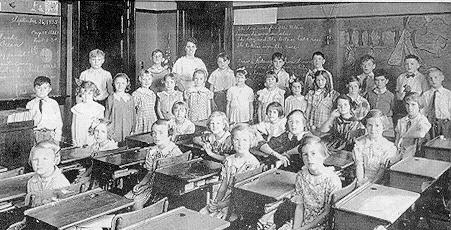By Michael Sharkey
Hampton Union, September 28, 1999
While most students find history in their textbooks at local schools, the buildings themselves echo with a rich history of their own.
The very first public school In New Hampshire was built on the site of the current Centre School in Hampton in 1649. AccordIng to Joseph Dow’s “History of Hampton,” published In 1893, the school opened on May 31, 1649, welcoming both boys and girls regardless of their family’s social stature. That females were allowed to attend school showed Hampton was ahead of the times, as the majority of schools In New England would not allow girls until 150years later, Dow states.
 A class at Hampton's Centre School in 1928.
A class at Hampton's Centre School in 1928.
Sitting in the first row are: Norma Farnham, Florence Kierstead, Barbara Scammon, Velma Mace and Priscilla Emery.
In the second row: Barbara Blake, Barbara Hansen, Grace Durant, (unknown), and Mildred Emery.
In the third row are: Eva Dalton, Priscilla Marston, Jeanne Marelli, Jeanne Colt, and Constance Young.
Standing in the back row are: Wilfred St. Pierre, (unknown), (unknown), Albert Wright, Pat Lessard, Forrest Perkins, Edward Tyler, Peter Olney, John Davis, Earl Blatchford, John Cushing, (unknown), John Carberry, and Hollis Blake.
[Courtesy photo/Tuck Museum.]
There is little written of the history of that first building, though Dow states it is believed to have burned down and been rebuilt on numerous occasions. The Centre School as we now know it was built in 1921 for $90,000, which makes it one of the oldest operating schools in the state, according to school officials. Further, School Administrative Unit 21 Superintendent Jack Bourgoin pointed out at the ground breaking of Centre’s $2.3 million addition last August that the first public kindergarten in the state was opened on September 8, 1947 in the present Hampton District Court house at 132 Winnacunnet Road.
At the opposite end of the scholastic spectrum, Winnacunnet High School became the state’s first cooperative regional school when it opened in 1958. A year before, In March of 1957, Hampton, North Hampton, Hampton Faalls and Seabrook voted to form a cooperative school board. By July of that year 52 acres of land had been purchased off of Landing Road to build a regional high school, and soon after voters approved $1.3 million for the building’s construction.
A total of 474 students attended WHS that first year. The current 1,100-plus student body is evidence of how much the region and its schools have grown.
With the construction of the new high school, Hampton Academy and High School became Hampton Academy Junior High. The building as we know it was built in 1940, but the academy’s history reaches back far before a date. In 1810, a building known as the Proprietary School was built on a spot on Meeting House Green at 40 Park Avenue. In 1821, it became Hampton Academy, and for 30 years the private school educated Hampton youth. In 1851 the historic building burned to the ground, and a second larger school was built in its place. Then in 1883, the building was moved to the larger current HAJH lot on Academy Avenue. According to Dow, the building was pulled by 160 oxen and 20 heavy horses over long cut and peeled trees which acted as runners. The academy opened as a free high school in 1885, and operated until 1940, when the current building was constructed for $114,000. The nearly 100-year-old building stood next to the new school for another year when it was purchased at auction for $200 by a Newburyport wrecking and salvage company.
 The third grade class at Centre School in 1935.
The third grade class at Centre School in 1935.
Sitting in the first row is Doris Pevear.
Second row: Gwendolyn Joubert, Mildred Quinn, Barbara Dunham, and Mildred Durant.
Third row: Marilyn Barnaby, Isobell Hamilton, Doris Clay, Kathleen Brown.
Fourth row: Ruth Lambert, Marie Trudeau, Marilyn Langmaid.
Standing in the first row are: Armand Gagne, Norma Ellis, Jacqulyn Cate, Raychel Burnham, Shirley Brown, Matilda McCool, Lorraine Parr, Dorothy Farnham, Gertrude Gauron, Dorothy Davis, Eleanor Lamott, Vernon Gauron, and Robert Walker.
Back row standing: Earl Tuttle, Forrest Leavitt, George Hackett, Charles Eliott, Ezra Trumbull, Frank Pevear, Donald Benoit.
[Courtesy photo/Tuck Museum]
The Marston School, as the elementary school is popularly known, actually bears the full title of the Adeline C. Marston School. The building is named after one of Hampton’s most dedicated and respected teachers who worked in local schools for 47 years. The school opened In January of 1957, and in February was dedicated to Marston who died In 1963.
When Hampton Union published its first newspaper in 1899, the budget for local schools was $2,722.22, according to the 1899 Town Report. Nearly a century later, the 1998 budget for Hampton schools reached over $11 million, while the Winnacunnet High School budget added $11.8 million. In further contrast, there were roughly 360 students enrolled In Hampton schools In 1899, while today the number reaches over 2,500.
The big news In Hampton schools in 1899 was the addition of a music program, while in 1999, the addition of police officers made headlines. The decision to add officers has sparked controversy, as some residents support the move while others fell they are not needed. The decision to place officers in the schools came in response to the deadly shooting rampage earlier this year at Columbine High School In Colorado.
